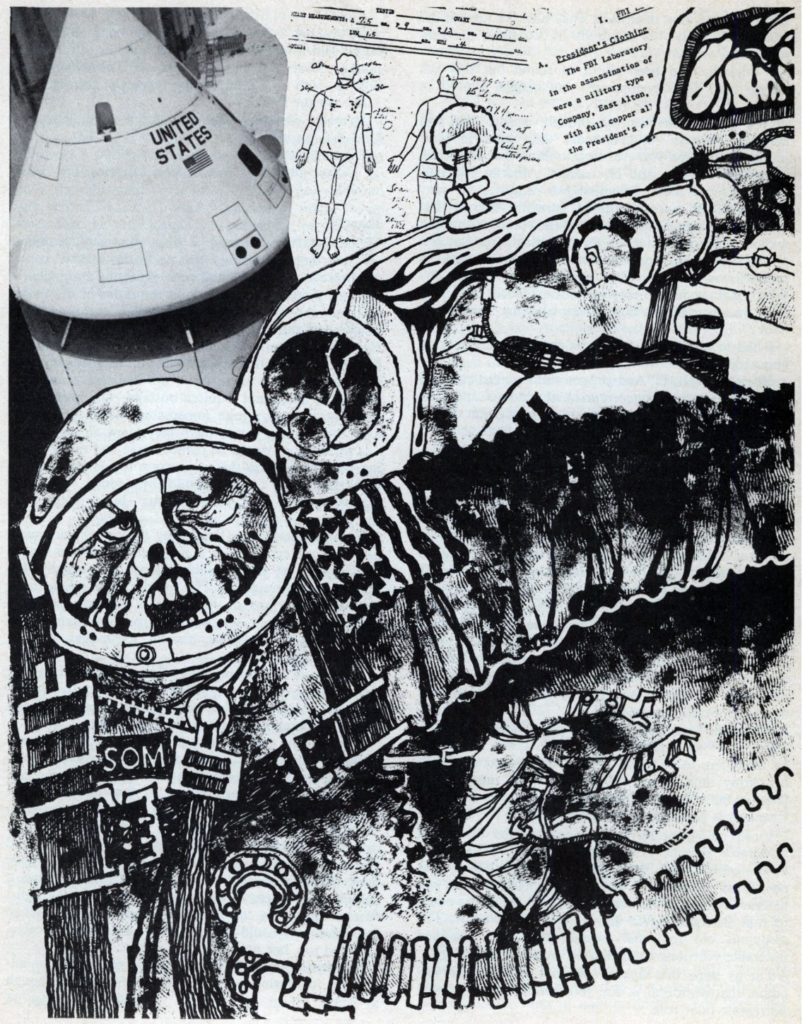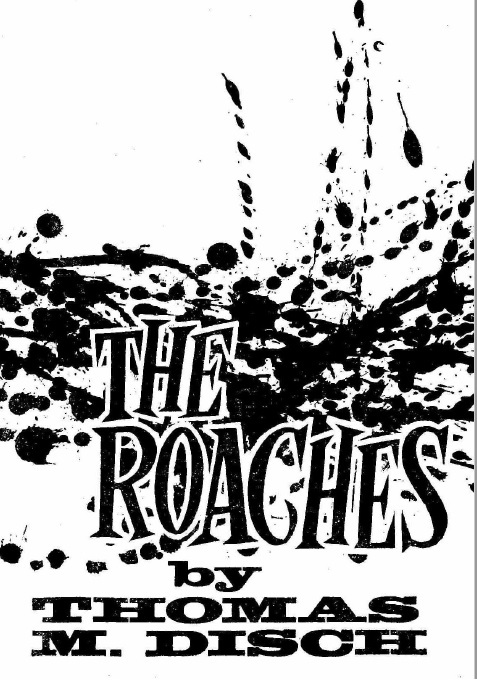
by Mark Yon
Scenes from England
Hello again!
The strange evolution of the ‘new’ New Worlds continues this month. Be warned – it’s not an issue to loan to minors!

Cover by Peter Phillips
This month’s “Leading Article” looks at our fascination with predicting the future – relevant to science fiction, of course! – but then uses this idea to analyse and review a book named The Art of Conjecture by French writer Bernard de Jouvenal. The future is less known than the past and is therefore more uncertain. Usual food for thought, but this seems less a thought experiment and more an editorial review.

Illustration by Zoline
Camp Concentration (Part 3 of 4) by Thomas M. Disch
In this third part, the fact that Louis Sacchetti is now fully infected with the Pallidine bug, and as it has been known to cause madness before death, leads to more madness and “ramblings”, as Louis puts it. Result: lots of religious iconography and internal ponderings in very short extracts ensue. Questions posed such as “Who is there to answer to the sky?” and vivid descriptions such as “My entrails are trodden down in the mire” may give you a clue where we’re going here.
The clever part is that there is a purpose to the madness. Much of the enjoyment here is in reading Disch’s well-constructed paragraphs and trying to determine what the meaning of it all is. It is very Ballardian, in that try-and-connect-the-deliberately-disjointed-paragraphs-together kind of way.
And yes, also in that Ballardian way, it is all starting to fall apart. More prisoners die. Sacchetti is both sicker and scoring higher than ever on the psychometric tests. Dr Busk seems to have run away from Camp Archimedes, and is replaced by Bobby Fredgren, who conducts more tests on Louis. We are also introduced to Skilliman, a person who seems like they’re straight out of Doctor Strangelove and on whom most of the story is spent describing and making up strange fictions about. I suspect that the reasons for this may become more important and more obvious next time. However, the omens are not good for a happy ending next month. 4 out of 5.
Still Trajectories by Brian W. Aldiss
Another month, another Aldiss, still telling us of a near-future Europe that has experienced psychedelic drugs as a result of Russia dropping hallucinogenic bombs in the Acid Head War. Last time it was about Charteris’s travelling around the English Midlands and becoming Saint Charteris, a god-like personality that is worshipped and adored. This time, we begin in Holland with Speed Supervisor Jan Koninkrijk, who describes the kind of decaying place Colin Charteris did in Multi Value Motorway last month. Lots of talk of cars and highways and speed, because we’re still channelling J G Ballard, but also with its talk of a depressed wife with no personality and the presence of ‘omnivision’ I think there’s a little bit of an homage to Ray Bradbury’s Fahrenheit 451.
The story steps up a gear (motoring analogy!) when it is revealed that Colin Charteris, the Mad Messiah last seen in England, is due to visit Jan’s home town of Aalter, on what could be seen as a Crusade in a convoy of cars. In his capacity as future-traffic-cop, Koninkrijk picks up Charteris and his girlfriend Angeline. Strange poetry ensues. Jan is affected by what he hears, and at the end abandons his mundane, routine life. The crusade rumbles on.
Like before in previous stories, there’s lots of vivid imagery and wordplay, not to mention things that are meant to mean a lot. Allegories of cars, speed, and crashing abound, although the poetry lost me a bit. Memorable though this story is, these Charteris stories do feel like little more than cut-up sections of a book, a serial in disguise. 3 out of 5.
Article: Psychological Streamlining by Christopher Finch

This month’s ‘artycle’ (I’ll keep saying it because I like it) examines the work of Peter Phillips, which combines Pop Art sensibilities with technical method. Lots of customisation and American imagery as a result.
I’m still not sure whether these articles are mind-blowing or just self-obsessed clap-trap with delusions of grandeur. Some of the sentences here are just ripe for parody. And yet I must admit that they’re showing me things I had never considered before, which I guess is partly the purpose of art. 3 out of 5.
Masterton and the Clerks by John T. Sladek

Here’s that story delayed from last month.
A sort of Kafka-esque satire which seems to be about the mindless routines and meaningless existence of bureaucracy in the modern office as seen through the observations of Henry on his fellow workers and in particular his boss, Mr. Masterton. As is now de rigueur for much of the New Wave stuff, it’s written in that cut-up style, with diagrams, memos and the like. It’s meant to be amusing, but feels also rather pointless and depressing, filled with people that you wouldn’t want to spend time with, never mind reading about in a far-too-long story. But that may be its point.
Unfortunately, or perhaps appropriately for a story set in an office, it reads like a copy of something else or something that we’ve seen before. It almost feels like Disch has written it. Not convinced that this one was worth the wait, to be honest. File in the “Life’s dull and then you die” filing cabinet, albeit perhaps with a faint smile on your face. 2 out of 5.
Article: A New Look at Vision by Christopher Evans

The return of Dr. Evans, who to me still feels a little like a British version of The Good Doctor Asimov. This month he’s looking at new developments in optics, a much-needed development for those of us who are short-of-sight. (I’m tempted to throw in the joke about “If only I could read the small print”, but I shall refrain.) It begins with facts I didn’t know about the eye, before discussing how contact lenses work, and finally explains the experiments on pattern, form and process that allow us a greater understanding of how our brain works. Another informative article on something I didn’t realise I needed to read about. 4 out of 5.
Book Reviews
You may have noticed, like I have, that there seems to be a trend in New Worlds at the moment about stories involving religion. Not sure why, but I am noticing many stories about God/Gods, religious icons, theology and all the rest of it. Perhaps they’ve always been there and I’m only just noticing them? Anyway, the detailed review this month by C. C. Shackleton is of a book by Alex Comfort, The Anxiety Makers, which initially examines the concepts of New Theology and New Mysticism.
All well and good. The article then links these concepts to Dr. Comfort's book to make the point (I think) that many of today's anxieties are related to ideas from Victorian times that doctors are obsessed with dealing with. It then goes into some detail on the origins of these anxieties, referred to as the “four horses of the nineteenth-century apocalypse” – masturbation, sexual intercourse, birth control and constipation. I can safely say that these are topics I would never have expected to read of in New Worlds, although to be fair it examines these issues in a rather matter-of-fact manner.

Some of the ideas examined here are quite complex. I'm not even sure that I got them, as there seems to be an assumption that I know something about the topic already. (I do not.) As a result, I'm not really sure of its relevance here, although as an article perhaps meant to shock, I guess it might sell a few more copies. Personally, though, it makes me feel like my copy of New Worlds should be hidden behind the newsagent’s counter… can’t see it being widely promoted on the shelves of my local W H Smiths.
The other reviews this month by James Cawthorn are less titillating and more genre based. Keith Laumer’s A Plague of Demons “moves along briskly, achieves some neat lines of hard-boiled humour and is, above all, entertainment.” Brief mention is also made of Robert Silverberg’s To Open the Sky (religion, again), but this is mainly descriptive rather than analytical.

Summing up New Worlds
Another wide-ranging issue, some of which is on topics I didn’t expect. I feel that the fiction is a minor part of the magazine this month, although it can’t be denied that the magazine seems to be going all out to broaden its readership. The Disch is becoming more obtuse, John Sladek’s Masterton and the Clerks was a disappointment, although I’m not entirely sure what I was expecting.
In short, a solid issue, but not an outstanding one. With the emphasis on articles, I have a feeling that whilst trying to gain new reader’s interest, the staff may be losing their traditional readership. I do wonder what the New Worlds readers of the 1950’s would make of this issue. There’s no denying that there’s science, but where’s the science fiction? Even the fiction seems more literary and less science-fictional than what has gone before.
And I realise that that may be the point.
In this brave new world of New Worlds there may be less space for spaceships and more room for sex – or at least adult topics. This fits in with the brief that Moorcock made his intent years ago, to modernise and adult-ise science fiction, and what the Arts Council want their grant to be used for, but based on what I’m seeing here I’m not sure that it means the magazine has found, or will find, a bigger, more interested audience.

A 21st anniversary issue – has it really been around that long?
Until the next!

![[August 26, 1967] The Shock of the New II – Sex and the Modern British SF Reader <i>New Worlds</i>, September 1967](https://galacticjourney.org/wp-content/uploads/2022/08/New-Worlds-cover-Sept-67-672x372.jpg)

![[June 26, 1967] Change is Here (<i>New Worlds</i>, July 1967)](https://galacticjourney.org/wp-content/uploads/2022/06/New-Worlds-cover-July-1967-672x372.jpg)

 Illustration by Zoline
Illustration by Zoline




![[October 24, 1966] Birds, Roaches and Rings, <i>New Worlds</i> and <i>SF Impulse</i>, November 1966](https://galacticjourney.org/wp-content/uploads/2021/10/New-Worlds-SF-Impulse-November-66-672x372.jpg)








